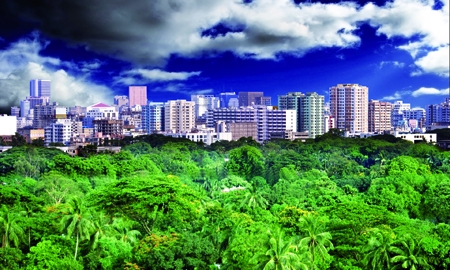Investors ahead of the curve keeping track of the South Asian nation are acutely aware that an unquestionably promising future lies ahead, underpinned by sustained social, political and economic development over the past three decades and a solid determination to make consistent, steady progress. Over the past decade, annual average GDP expansion was 6 per cent, export growth was 15 per cent and revenue growth was 20 per cent year on year.
Stable prices and exchange rates, along with high foreign currency reserves and growing remittances from Bangladeshis overseas, which have increased 5.1 times between 2002 and 2012, have contributed greatly to this achievement. Furthermore, consistency in government policymaking and openness to trade has helped bolster economic growth.
International ratings attest that Bangladesh’s sound macro-economic fundamentals and credit worthiness support its ranking as second top performer in South Asia, after India. It has been included in Goldman Sachs’ Next-11 (or N-11) countries to watch, as well as JP Morgan’s ‘Frontier Five’. The economy is in transition from one dominated by the public sector to one led by private enterprise. “Geographic location, accessible to international land and air routes and a large domestic consumer market of 163 million could be major components for foreign investors to invest in Bangladesh,” comments Prime Minister Sheikh Hasina.
The ready-made garments industry accounts for almost 78 per cent of export revenues. Other sectors such as frozen food, leather, ceramics, home textile, pharmaceuticals, ICT and shipbuilding are growing and fertile agricultural land and substantial reserves of natural gas and coal are of note.
In June, the Bangladesh Investment Summit held in London “unlocked opportunities for European investors,” says Mohamed Mijarul Quayes, High Commissioner for Bangladesh to the UK, and showcased “the wide, wide world beyond apparels, including the challenge of moving up the value chain. It looked at which export-led industries have positive prospects over the next five years other than ready-made garments.”
However, the economy’s biggest asset is its plentiful supply of an energetic and competitive labour force, according to Mr Quayes. Bangladesh is one of the most densely populated countries on Earth: more than 163 million people live in a country twice the size of Ireland, which by comparison is home to just under 5 million inhabitants. “What the rest of the world sees as overpopulation, we see as a demographic asset,” comments Information Minister Hasanul Haq Inu.
“When we talk about our economic performance and its prognosis, it is not just figures that we talk of; there is a human face to it,” says Mr Quayes. “Consider the leap in per-capita GDP to $923, the drastic reduction in poverty, improvement in the quality of life, livelihood and lifestyle, halving incidence of hunger, women’s empowerment across the socio-economic spectrum, and the full range of social indicators. I must hasten to add that this is a journey and we have not yet reached our destination.”
Bangladesh is an active participant on the global stage calling for effective initiatives on all fronts to tackle climate control and has launched the Bangladesh Climate Change Trust Fund designed to “lead by example and also catalyse collective action globally.”
The UK has long enjoyed strong trade and investment relations with Bangladesh. Exports to the UK rose 18.5 per cent last year, to £1.68 billion, while imports from the UK hit £216 million. Culturally, the bilateral bonds of friendship are further strengthened by the half a million Bangladeshis who have made their home in the UK.
Artistically, Bangladesh is also on an upswing, with artists such as the eminent Madrid-based Bangladeshi painter Monirul Islam gaining greater prominence and influence around the world. “Today, Bangladeshi art is characterised by a tremendous creative surge, diversity and vitality,” says Mr Quayes. “While the contemporary draws from and builds on the past, nascent trends offer trajectories that could very well be on way to creating their own rhetoric.”

2 COMMENTS
A country with enormous potentiality. You will love it. Trust me.
may Allah bless those who help Pakistan.